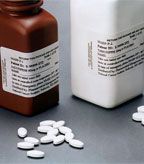US Task Force Recommends Breast Cancer Medications for High-Risk Women
The US Preventive Services Task Force, an influential panel of experts, said that women at high risk for breast cancer should consider taking breast cancer drugs to decrease their risk.
The US Preventive Services Task Force, an influential panel of experts, said that women at high risk for breast cancer should consider taking breast cancer drugs to decrease their risk. The analysis of the research on which the recommendation is based is published in the Annals of Internal Medicine. The panel stated that for those women who have a benign breast biopsy history, a family history of breast cancer, early menstruation, and late first childbirth, tamoxifen and raloxifene could lower their risk of being diagnosed with breast cancer. The drugs have side effects, including thromboembolic events, cardiovascular disease events, uterine abnormalities, and hot flashes, but after reviewing seven randomized, controlled trials in women without pre-existing breast cancer, the panel concluded that the benefit of the drugs in breast cancer prevention may outweigh the side effect risks.

USPSTF recommends tamoxifen and raloxifene for women at high-risk for breast cancer
Heidi D. Nelson, MD, of the Pacific Northwest Evidence-Based Practice Center at the Oregon Health & Science University in Portland, Oregon, and colleagues reviewed seven randomized, double-blind, placebo-controlled or head-to-head trials of tamoxifen or raloxifene in a meta-analysis. All of the tamoxifen and several of the raloxifene trials aimed to determine the rate of breast cancer incidence among high-risk women who had no history of breast cancer.
The trial meta-analysis suggests that chemoprevention can decrease the number of invasive breast cancer cases by seven or nine cases out of 1,000 over a 5-year treatment period. This prevention can reduce the number of estrogen-receptor positive breast cancers. A separate set of recommendations was made for breast cancer prevention in women who have a germline mutation in either of the BRCA genes.
The recommendation by the panel, based on the analysis of clinical trial data, is for healthy women, age 40 to 70. The panel recommends women discuss their risk with their doctors and opt to take either of the two drugs as a prevention measure only if their risk of blood clots or stroke is low. According to the panel, women who are most likely to benefit from the treatment are those who have a 3% or higher chance of developing breast cancer over a 5-year period.
The panel noted that other medications including tibolone, lasofoxifene, and exemestane have also been shown to reduce breast cancer risk in clinical trials. For example, exemestane reduced invasive breast cancer incidence by 65% among high-risk postmenopausal women after 3 years of therapy in a single trial. However, these drugs are not approved by the US Food and Drug Administration for this purpose.
Both tamoxifen and raloxifene work by inhibiting the effects of estrogen. Tamoxifen has been used for more than 30 years in the United States. It is commonly used as an adjuvant therapy to treat early-stage estrogen-receptor positive breast cancer in both postmenopausal and premenopausal women to prevent breast cancer from recurring.
The panel of primary care physicians reaffirmed their previous recommendations from 2002, but as a result of more data on risks and benefits, now suggests that clinicians offer drugs as a way to prevent breast cancer. However, few women have opted to take these drugs to prevent breast cancer because of the side effects. Besides hot flashes, tamoxifen can increase the risk of endometrial cancer and cataracts. The studies found that the side effects, especially blood clots, are more likely in women age 50 and older.
Despite the previous recommendations, the use of the two drugs has been low in the United States, and a clear-cut way to identify the best candidates for the therapy is still not clear. More trials are needed to better identify high-risk patients who are good candidates for tamoxifen or raloxifene to prevent breast cancer.